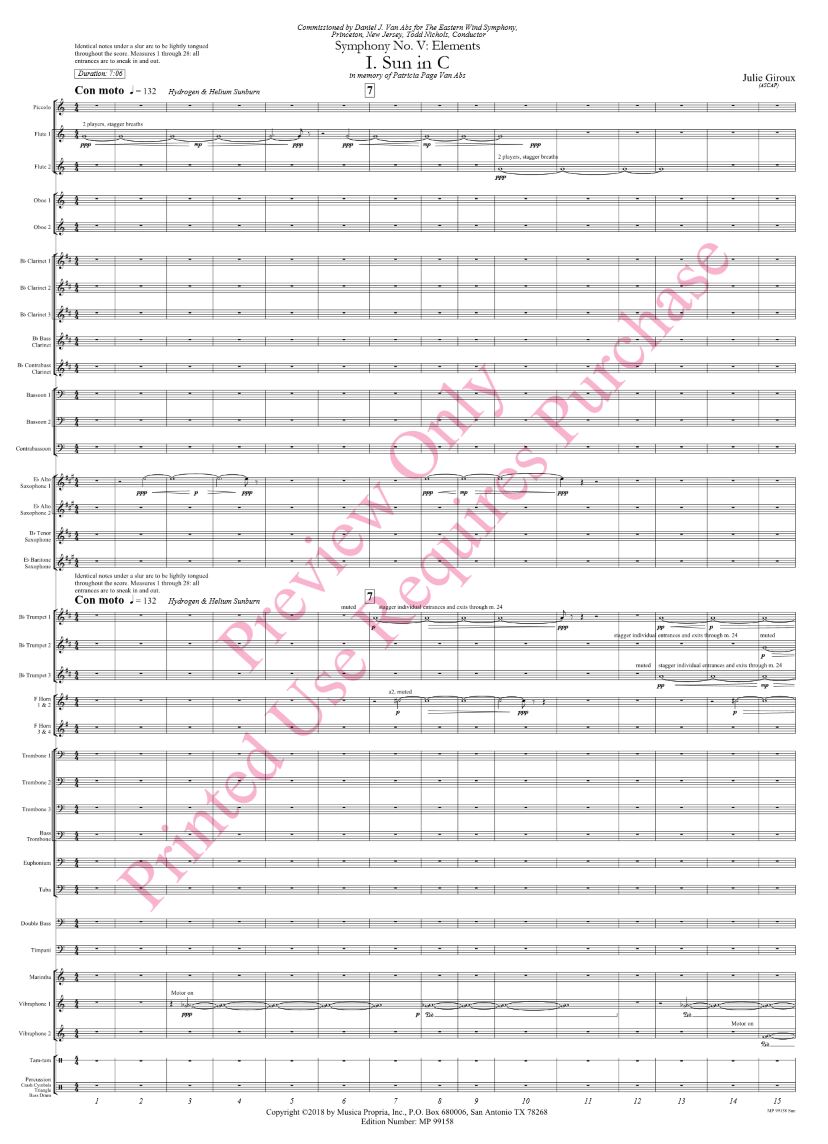Instrumentation
1 - Piccolo
4 - Flute 1
4 - Flute 2
1 - Oboe 1
1 - Oboe 2
4 - B♭ Clarinet 1
4 - B♭ Clarinet 2
4 - B♭ Clarinet 3
2 - B♭ Bass Clarinet
1 - B♭ Contrabass Clarinet
1 - E♭ Contra Alto Clarinet
1 - Bassoon 1
1 - Bassoon 2
1 - Contrabassoon
2 - E♭ Alto Saxophone 1
2 - E♭ Alto Saxophone 2
2 - B♭ Tenor Saxophone
1 - E♭ Baritone Saxophone
3 - B♭ Trumpet 1
3 - B♭ Trumpet 2
3 - B♭ Trumpet 3
2 - F Horn 1 & 2
2 - F Horn 3 & 4
2 - Trombone 1
2 - Trombone 2
2 - Trombone 3
2 - Bass Trombone
2 - Euphonium B.C.
2 - Euphonium T.C.
4 - Tuba
1 - Double Bass
1 - Timpani
1 - Piano
2 - Orchestra Bells, Chimes
1 - Marimba
1 - Vibraphone 1
1 - Vibraphone 2
4 - Percussion (Tam-tam, Crash
Cymbals, Triangle, Bass Drum)
Symphony No. V: Elements - I. Sun in C
Grade 5
for concert band
by Julie Giroux
Commissioned by Daniel J. Van Abs for The Eastern Wind Symphony,
Princeton, New Jersey, Todd Nichols, Conductor
PROGRAM NOTES
Before composing Sun
I researched all the science I could concerning the sun’s age, projected life span, atomic makeup, flares, and other interesting facts. Formed approximately 4.6 billion years ago and with approximately that many years left, the sun is a radioactive middle-aged ball of hot plasma comprised of 73% hydrogen and 25% helium. Once the sun’s hydrogen fusion core diminishes to a critical level, the sun will go from being a classified G-type star referred to as a yellow dwarf to being a Red Giant and will render Earth uninhabitable roughly 5 billion years from now.
The opening of Sun
actively describes the dynamo process of constant motion in and on the sun. Broken motifs are stated, changed, repeated and grow with strength of numbers and dynamics for 59 quickly paced measures ending in the first sunrise witnessed by earth represented by a huge open fifth C chord which is neither major or minor as there are no 3rds. In my mind, I did not see the sun as good or evil – just existing – thus no major or minor overtones. The middle section of Sun
depicts the sun more as a sentient being with the music showing the loneliness of floating in space for billions of years; the monotony and perhaps the unavoidable onset of insanity and depression such existence would impose on a human as a soulless planet. The sun is then musically devoured by the chemical reactions and builds back up into another huge chord, but this chord is a C Major chord, representing the joy of life that the Earth enjoys, for without the sun, life on earth would not exist. After that chord the music captures the magnificent power of the sun with huge bold chords surrounded by an arsenal of 32nd notes in the woodwinds and keyboards representing the artificial life of the sun and is meant to sound like the artificial synthesized music sounds and textures of the late 1980-1990’s electronic instruments. The miracle of the sun ends the work with another, final massive C Major chord.
*As a side note, when I was actively composing and trying to create the feel of oppressive heat, I would always picture in my mind the desert scenes from Lawrence of Arabia.
I always felt like that movie captured the power of the unrelenting sun and heat better than any other motion picture
- J.G.
MP 99158
Duration: 7:06
Score & Parts: $135.00
Score only: $25.00
I. Sun in C
II. Rain in D♭
III. Wind in E♭


Home | Composers | Grade Levels | Order Form | Contact
©2010 Musica Propria, Inc.

